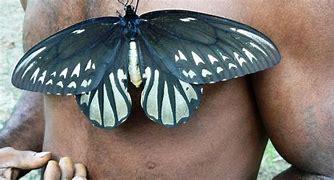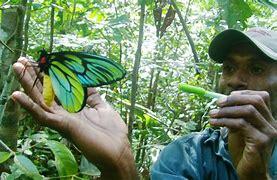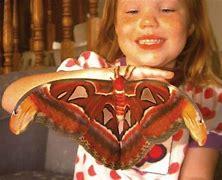Results: Queen Alexandra's Birdwing
Published on 08/10/2022
The largest butterfly on earth, with a wingspan of 30 cm (1 foot) is Queen Alexandra’s Birdwing (Ornithoptera alexandrae), which is found exclusively in Papua New Guinea (specifically in the Popondetta Plain). https://www.scienceabc.com/nature/animals/what-is-the-worlds-largest-butterfly.html is the source for this survey.

QUESTIONS
GO to COMMENTS
Comments
1.
1.
Which of these Queen Alexandra's Birdwing facts are you familiar with?

The species was first discovered in 1906 in Papua New Guinea by the naturalist, Albert S. Meek, who chanced upon an individual on one of his walks in the rainforest. As a collector, he did not think twice and immediately shot the gigantic butterfly, in order to add to his collection. However, before doing so, he took the specimen to Walter Rothschild, a world-renowned zoologist.
5%
109 votes
Rothschild then helped prepare the first-ever scientific description of the species. He named it Queen Alexandra's Birdwing in honor of the then ruling queen, Queen Alexandra, wife of King Edward VII of England (1841-1910).
6%
127 votes
To date, scientists still don't know how many individuals there are of this species in the wild, and there have been no recent population surveys. In 1992, researchers found only seven larvae, one pupa, and 167 adults. However, these numbers are most likely over-representations, considering how difficult it is to count flying organisms.
3%
68 votes
None
84%
1921 votes
All of the above
6%
143 votes
2.
2.
Which of these Queen Alexandra's Birdwing traits have you heard about?

This species prefers open primary and secondary rainforests or remote plateaus, because there is more light. They avoid thorny habitats because of their large wingspan and delicate wings. Adults usually fly above the upper forest canopies so they can easily spot the flowers of rainforest trees.
4%
93 votes
Male Queen Alexandra's Birdwing have a wingspan of 14-20 cm, whereas females have a much larger wingspan, between 18.7 and 30 cm. Both sexes have a yellow abdomen, but vary in their body colors. Females have a dark brown body with cream markings on the upper surface, while males have a black body and a yellow upper surface, in addition to pale green and blue markings.
5%
120 votes
The Queen Alexandra's Birdwing has been legally protected in Papua New Guinea since the late 1960s. It is also listed in Appendix I of CITES (1987). However, this species is under severe threat. The biggest concerns facing Queen Alexandra's Birdwing is that it is severely restricted to one region—Papua New Guinea. Even there, it faces many threats, both natural and human-induced.
5%
107 votes
None
83%
1920 votes
All of the above
6%
130 votes
3.
3.
Which of these Queen Alexandra's Birdwing facts have you heard of?

Queen Alexandra's Birdwing has four life stages, which last between 5 and 7 months. The butterfly begins its life as an egg. Adult females lay large-sized eggs, around 0.41 cm in diameter. They usually lay their eggs on pipevine plants (Aristolochia schlecteri), as the leaves of this plant act as a food source for the eggs as soon as they hatch.
4%
102 votes
In the next life stage, baby caterpillars hatch from the eggs. These tiny new life forms have a black body with long, fleshy and red tentacles all over. They also have a cream-colored spot in the middle of their black bodies. Once they hatch, they immediately begin feasting on the pipevine leaves where they were laid, and continue to do so until the end of this stage. As they grow, the caterpillars lose their old skin (molt) several times and slowly transform into a pupa.
6%
134 votes
All the magic happens in the pupa (or cocoon) stage. During this part of the cycle, the caterpillar's body transforms into a butterfly. However, during this stage of the life cycle, the caterpillar does not eat or drink until it fully transforms into its final form.
5%
111 votes
During the last stage, the caterpillar emerges as an adult. Here, the butterfly feeds mainly on nectar, but does not grow any further. Its sole duty during this stage is to mate and reproduce so that its population can grow. Adult males usually have a short life span of around three months, while females live up to twice that long.
3%
78 votes
None
81%
1872 votes
All of the above
7%
153 votes
COMMENTS


